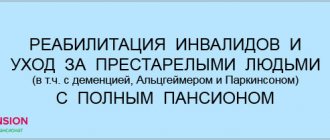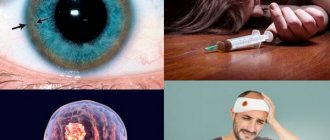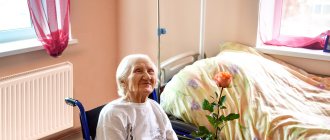In medicine, a degenerative neurological disorder is called Parkinson's disease. This pathology is characterized by constant progression. To date, scientists have not yet invented a medicine that can completely cure patients with this diagnosis. But timely therapy and special exercises can provide a positive result.
Parkinson's disease most often occurs in older adults aged 55 to 65 years. But there are cases where small children suffered from this disease. This deviation is called in medicine the juvenile form. Treatment of parkinsonism for patients of all age groups should be carried out only under the supervision of a physician. Today we will talk about Parkinson's disease and patient care.
Specialists from the boarding house for Parkinson's patients "Trust" are ready to provide professional care for your relative.
Symptoms of Parkinson's disease
The disease is usually accompanied by dysfunction of the musculoskeletal system. This is caused by pathological changes occurring in the brain tissue.
Most often, patients suffering from Parkinson's disease experience the following symptoms:
- tremor. Trembling of the limbs is an obvious sign characteristic of the first stage of this disease. Most often, hand tremors occur when they are in a quiet position, but in some cases, trembling occurs when moving;
- damage to the facial muscles. This symptom is characterized by trembling of the lower jaw and eyelids. If the facial muscles are affected, the patient has difficulty pronouncing words. In some situations, patients are unable to swallow food;
- This phenomenon also often occurs in the first stage of development of Parkinson's disease. As the pathology progresses, the appearance of stoop is characteristic. Being under constant tension, the joints bend. Increased tone leads to the patient experiencing pain and discomfort;
- slowness of movements. People with Parkinson's disease often shuffle when walking because they have difficulty lifting their legs. A person may fall and therefore requires constant support and supervision. Patients suffering from this disease may almost completely lose self-care skills;
- profuse salivation. This symptom also has a negative impact on speech and swallowing functions, making them difficult;
- intellectual impairment. This symptom is expressed in the form of severe memory deterioration and loss of sound thinking ability. This condition is not typical for all patients suffering from parkinsonism, but if it appears, rapid progression is observed;
- mental problems. In many patients diagnosed with this disease, doctors observe chronic depression;
- erectile disfunction. A common symptom in male patients. When this pathology is identified, a psychologist is involved in treatment therapy.
If the disease is in an advanced form, the patient experiences disturbances in the functioning of the gastrointestinal tract, expressed in spontaneous bowel movements. The progression of Parkinson's disease leads to a worsening of existing symptoms and the appearance of new ones, so patients with this diagnosis require constant monitoring by specialists.
Specialists at the Doverie boarding house will monitor the well-being of an elderly person suffering from Parkinson’s disease.
Another common problem that occurs in people who suffer from Parkinson's is insomnia. Against the background of a pronounced psycho-emotional disorder, sleep disturbance occurs. Also, the appearance of insomnia is often associated with an increase in muscle tone, due to which the patient experiences pain and difficulty when turning to the other side while sleeping.
One of the most significant motor disorders in patients with Parkinson's disease (PD) is walking impairment. It is its severity that largely determines the severity of the condition and the patient’s quality of life. As a result of numerous domestic and foreign studies [1-5], it has been established that walking impairment is an independent manifestation of PD, which has a special pathogenesis, requiring a specific approach to correction, and which can probably be considered the fifth cardinal sign of parkinsonism along with hypokinesia, rigidity, and tremor rest and postural disorders.
Gait disturbances in patients with PD at the onset of the disease depend on hypokinesia and rigidity. As a result, there is a slow initiation of walking, a decrease in its speed and a decrease in the size of the step (microbasis). The gait becomes shuffling, while the patient almost does not lift his feet off the floor, and a “mincing” step occurs. Poor posture in PD occurs as a result of constant flexion of the cervical spine and the formation of a “bent” position of the torso with kyphosis. When walking, the torso may lean further forward. To maintain balance and avoid falling, patients, trying to “catch up” with the body’s center of gravity, are forced to gradually accelerate (propulsion). Some patients experience retro- and lateropulsions. Quite often in PD, the phenomenon of freezing when walking occurs .
.: freezing). As PD progresses, freezing may occur more frequently and last longer, significantly impairing walking.
The role of postural instability is especially significant at the late stage of the disease, when a shift in the patient’s center of gravity does not cause compensatory movements of the trunk and limbs, which leads to falls [3, 6, 7].
There are three types of hypokinesia in parkinsonism [8]. The first type is secondary slowness (secondary akinesia), caused by muscle rigidity and manifested by a violation of reciprocal and rapid repetitive movements (acheirokinesis, difficulties in alternating pronation-supination). In the second type, there is an impoverishment of fine and automated movements, which does not depend on the severity of muscle rigidity (primary akinesia). These two types of hypokinesia can be treated with levodopa. The third type is characterized by a lack of motivation to act and is manifested by difficulties in starting movement (initiation of walking). Treatment with levodopa drugs not only does not reduce, but can even lead to an increase in the severity of this phenomenon, which largely depends on the dysfunction of nondopaminergic mechanisms [5, 9, 10].
A decrease in general activity in combination with a kyphotic alignment of the spine and general hypokinesia, as a rule, leads to respiratory disorders.
Problems in diagnosing gait disorders in PD.
The mechanisms of development of gait disturbances in various diseases and the possibility of their compensation, as well as the dynamics of changes in gait disturbances and assessment of the results of therapy suggest the development of instrumental methods of gait analysis [11]. Various ichnometric techniques are used to record the spatial characteristics of a step. Currently, the most common is the rather labor-intensive impregnation method of ichnometry, which consists of manually measuring the distance between foot prints on a paper strip [12, 13]. Mechanical methods of ichnometry using ink recorders attached to shoes are also inconvenient. Optoelectronic methods are difficult to use and expensive. Electrical ichnography methods are more accessible, but most of them require the use of special shoes or the connection of electrodes attached to the patient’s shoes and a reading device using a cable, which changes the walking pattern and is reflected in the final results of the study [14-17]. In this regard, the tasks of creating a simple but sufficiently informative method for recording gait and selecting criteria for assessing gait in order to more fully understand its mechanisms in health and pathology are extremely relevant.
To objectify walking parameters, the authors, together with the experimental design bureau of the Zheleznogorsk Mining and Chemical Combine, Krasnoyarsk Territory, created a device for determining a person’s walking-speed characteristics (USHCH)1. This is a 10 m long contact track with electrical sensors that respond to closure with a special self-adhesive contact disk made of aluminum foil with a diameter of 5 mm. One contact sensor is attached to symmetrical points of the subject’s shoes. When walking, the contacts are closed, the corresponding information enters the computer data conversion unit, which allows you to analyze the length of each step, the time spent on a step, the frequency distribution of various step lengths, the speed of a person’s movement, as well as save and statistically process the data obtained. The advantages of the USHCH include the use of familiar shoes by the subject and the absence of influence on the gait of the contact sensor, as well as the speed and convenience of saving data in electronic form.
Typical graphs of the results of examination of healthy young, healthy elderly patients with BE are presented in Fig. 1. From the presented graphs it is clear that healthy young people are characterized by a significant standardness of gait (accordingly, low variability in step length) with small fluctuations relative to the average. As a result, the graph has the shape of a pyramid with a narrow base. In healthy elderly people, the base of this pyramid expands due to a greater spread in step lengths (greater variability in step length). In a patient with PD, the term “mincing gait” is objectified, with marking time and phenomena of motor fluctuations in the form of freezing, which is manifested by a large number of steps of minimal length.
Rice. 1. Typical graphs of survey results. a - healthy people aged 19-29 years; b - healthy aged 56-75 years; c — patients with B.P. Here and in Fig. 2: the x-axis is the step length (cm), the y-axis is the frequency.
Another diagnostic assessment approach is to formalize and standardize the examination without the use of special devices. For example, the time it takes to travel a certain distance is studied or, conversely, the distance traveled per unit of time is determined.
Methods of tempo-rhythm gait correction (TRCG)
Already since the 19th century, the phenomenon of paradoxical kinesia has been known, which consists of a decrease in oligobradykinesia under the influence of periodization of time (the sound of a march, rhythmic commands, etc.) or space (steps, floor with contrasting floorboards, etc.) [9, 18, 19]. Attempts have been made to improve the patient's walking using these methods. Thus, the positive effect of patients walking to music was described, consisting in an increase in step length [20, 21]. The technique of dynamic visual afferentation [7] has also shown significant effectiveness, but its non-laboratory use is currently difficult. Meta-analyses have shown that sound stimulation is more effective than visual stimulation in terms of restoring walking, since it affects not only step length (like visual stimulation), but also its speed and rhythm [22-25]. In addition, audio stimulation is more accessible for subsequent use in order to maintain the positive effect [25, 26].
M. Thaut et al. [21] proposed using a single frequency of sound signals (the sound of a metronome recorded over music in the basic mode and accelerated by 10%) to correct gait disturbances in patients with PD, which did not take into account the individual characteristics of the patients and the degree of gait disturbance. The study involved a total of 21 patients with stages II-IV of the disease according to Hoehn-Yahr. This, obviously, somewhat blurs the results of the study, preventing a full study of the effectiveness of therapy at different stages of the disease. The authors assessed the results of correction during both on and off periods. A significant difference from most other works is the objectification of walking with the placement of markers on four points of each foot using a computerized installation, which significantly increases the reliability of the data. In general, relatively little effectiveness of the treatment method used was demonstrated. The authors also stated that simply changing step length is not enough to significantly improve walking.
In our opinion, special attention in the restorative treatment of walking disorders in parkinsonism should be paid to the patient’s individual abilities to maintain different walking paces, their dynamic adjustment depending on the stage of the disease and drug regimens, based on quantitative registration of step parameters during the treatment process [25 -27].
We have developed and put into practice a method for treating walking disorders in parkinsonism, which consists of using a TRK, based on the principle of RB2. After a detailed study of the walking parameters, the patients were tested to select the individual frequency of external stimulation, which was carried out as follows: the patient was asked to walk under a frequency specified by the sound in the range from 40 to 120 signals per 1 minute (each subsequent passage was carried out with an increase in frequency by 5 signals per 1 minute ), synchronizing your steps with the sound signal. If the patient was not able to synchronize the step with the sound signal when the frequency increased, testing was stopped. The study was carried out at the USHCH with the determination of linear walking parameters. Changes in the motor pattern of walking were visually assessed, and the adequacy of physical activity was monitored by determining the patient's heart rate and blood pressure. The optimal rhythm was considered to be one in which the step length was greatest with fewer steps and the patient feeling comfortable. During the course of treatment, an individually selected optimal rhythm of sound signals was recorded on an audio cassette, which the patient could use while walking using a portable audio player and headphones. To record the optimal frequency (FO) and then use it in classes with patients, we used a flash player and an electronic device we developed for training movements3.
Classes to correct walking with step synchronization under OC were carried out daily for 5-20 minutes, 3 to 6 times a day, depending on the patient’s condition. Thus, during walking synchronized with the tempo of sound stimulation, the motor stereotype of pathological gait changed, which, however, quickly faded during independent walking at an arbitrary pace without reinforcement by exogenous stimulation. In order to consolidate the achieved effect, patients were given an audio cassette with an OC recorded on it, which they used while walking using an audio player and headphones. RFs were also recorded on the patients’ flash player or given a device we developed for walking training, which the patients used in everyday life (walking around the apartment, walking on the street, etc.).
According to our observations, in some patients with PD, the effect of using sound stimulation with OC in relation to a sharp increase in step length was comparable to the effect of levodopa drugs. We present graphs of the results of assessing the walking of a patient with stage III PD at a free pace and synchronized with the frequency of the supplied sound signals (Fig. 2). The results are also presented in table. 1 and 2.
Table 1. Results of a gait study in patients with stage II PD according to Hoehn-Yahr Note. KVS is the coefficient of step variability, ADS is the average step length (cm).
Table 2. Results of a gait study in patients with stage III PD according to Hoehn-Yahr
Rice. 2. Results of examination of patient M., with stage III PD according to Hoehn-Yahr. a — in free tempo mode; b - in walking mode, synchronized with sound signals supplied from the OV.
It was found that the TRKH method, used in the treatment regimens for patients with PD stage II according to Hoehn-Yahr, showed higher efficiency in gait restoration than in the comparison group. The positive dynamics of walking indicators (WDS, KWS) exceeded those in patients with PD with stage II according to Hoehn-Yahr, in whose treatment only antiparkinsonian drugs were used. Walking disorders in patients with PD with stage III according to Hoehn-Yahr turned out to be more pronounced compared to patients with stage II. In this regard, the need to restore walking in these patients was significantly higher. The positive effect of the use of TRKH in patients with stage III PD also turned out to be significantly higher compared with those receiving antiparkinsonian drugs.
Stimulus selection has been carried out in other studies, in particular, an attempt was made to improve the quality of walking in patients with early stages of PD using TRX with an audio signal that was selected individually [28]. To do this, the patient walked a distance of 9 m 15 times at a comfortable speed, the average rhythm value was calculated (the authors do not indicate which objective control methods were used), and then the patient was asked to walk using the given rhythms. The value of the work is reduced by the small number (11 people) of those examined and the impossibility of extrapolating the data obtained to patients with late stages of BP. This is due to the fact that during moments of severe hypokinesia the patient’s rhythm can be very low, and increasing it is unlikely to significantly change walking. In our opinion, the disadvantage of the work is the underestimation of other walking parameters.
An alternative option for TRKH is the use of a special device that sets the rhythm of movement for the patient through weak electrical impulses, alternately (alternating between the left and right legs) irritating the skin and causing weak muscle contraction4. The device is attached to the patient's belt, electrodes are installed on the front surface of both thighs (one for each leg). The strength of irritation is individually set ,
which is determined by subjective sensations: there should be a clear sensation of the signal passing and slight tension in the muscles of the anterior thigh. Irritation should not be accompanied by subjective unpleasant sensations. Then the stimulation rhythm is set in the range from 60 to 110 pulses per 1 minute in increments of 5 pulses per 1 minute (a range different from that for sound stimulation is associated with the technical capabilities of the device). Electrical impulses alternately stimulate the right and left limbs. The patient is asked to synchronize steps with the given stimuli. Testing is stopped if the patient is unable to synchronize when the frequency increases. The study was carried out at the USHCH, the change in the motor pattern of walking was visually assessed, the adequacy of physical activity was monitored by determining the patient's heart rate and blood pressure. The optimal rhythm was considered to be the one with the longest step length with fewer steps and a comfortable state of health.
This stimulation technique was used in a relatively small number of patients with PD, however, in one of the monocenter studies in patients with vascular parkinsonism (VP) with the presence of active (sound stimulation) and passive (no impact) control, a significant increase in SRS and a decrease in EPS were found. The results are presented in more detail in Table. 3.
Table 3. Data on the initial state of walking in subgroups of SP Note. * — differences are significant when compared with the comparison group (p<0.01).
The effectiveness of both techniques, in our opinion, should be associated with the mobilization of additional compensatory mechanisms in the form of cortical control of walking, implemented through the premotor cortex, as well as, possibly, the additional influence of the cerebellar pathways, compensating for the dysfunction of the basal ganglia and the associated additional motor cortex. One of the arguments in favor of this concept is the work of M. Mak et al. [29], who showed a significant deterioration in walking compared to healthy people in patients with PD when their attention was diverted to calculations, and, on the contrary, a greater level of positive changes (length, speed and rhythm of walking) in patients with PD compared to healthy people when presented with audiovisual incentives. Walking was significantly improved by using both auditory and visual stimuli, but their combination did not significantly increase the effect of TRKH [30]. This may be explained by the individual dominance of the patient’s perception of signals of one type or by elements of distraction when using two signals of different types, which did not allow the positive effect to be summed up.
In a single-blind study on a large group of 153 patients, data were obtained on a small (about 4.2%) but significant reduction in episodes of “freezing” walking when using the methods used by A. Nieuwboer et al. [31]. Similar data were obtained from a study of the effectiveness of audio and visual stimulation [32]. A significant effect on freezing gait (10% reduction) and a higher level of evidence were demonstrated in one of the newest studies in this field [10]. It had a randomized crossover design: for 2 weeks, the experimental group was engaged in walking with stimulation of an individually selected modality (audio, visual, tactile - cane, mental - music), and the comparison group did not receive such therapy. Despite the relatively small sample (23 patients were randomized), the results are beyond doubt, given the carefully designed design, strict requirements for the inclusion of patients (51 were screened) and competent statistical processing.
Methods of exercise therapy and occupational therapy in the treatment of PD
The thesis about the benefits of breathing exercises for patients with PD is confirmed by the data from the work of R. Inzelberg et al. [33]. The patients were divided into a comparison group (false breathing exercises) and a main group (breathing exercises). Significantly better results were in the main group.
Considering programs aimed at exercises for skeletal muscles from the perspective of evidence-based medicine, it can be stated that any systematic exercise, including independent home exercise, has a positive effect on motor functions [34]. A meta-analysis conducted by the Cochrane Movement Disorders Group (33 studies, 1518 patients) fully confirms the value of exercise therapy compared to sham (or no intervention) in relation to speed and step length, balance and motor functions [35]. Systematic exercises under the supervision of exercise therapy specialists are significantly more effective than independent exercises at home and have a positive effect on motor functions (including UPDRS scale scores, assessed using the PDQ-39) and daily activity (assessed on the NEADL scale) [36]. The use of a specialized exercise program (ParkFit) in 540 patients with PD with reduced mobility in a randomized controlled trial did not show a significant effect on activity on the LAPAQ scale, but other secondary outcome measures (including an activity diary and a 6-minute walk test) showed significant improvement [37]. We emphasize that the study concerns not just patients with PD, but patients with reduced motor activity. Exercise therapy does not have a significant effect on the incidence of falls [35, 38]. Occupational therapy has a positive effect on quality of life (assessed by PDQ-39), daily activity (assessed by NEADL) [15].
Transcranial magnetic stimulation (TCMS)
After the first optimistic isolated reports on the use of TCMS for patients with PD, studies appeared indicating the low effectiveness of this method [39]. Apparently, the problem is related to the selection of the optimal stimulation mode, primarily the frequency of stimulation and its area: for example, in this study, a frequency of 50 Hz was used. Another randomized trial [40] had a comparison group (sham TMS) and two intervention groups with a frequency of 10 and 1 Hz. The data obtained indicate a significant improvement (about 6.8 points on the UPDRS scale) in the group receiving stimulation with a frequency of 1 Hz, while stimulation with a frequency of 10 Hz had a much smaller and unstable effect. An open-label, uncontrolled study [25] demonstrated the effectiveness of 9 Hz TCMS in combination with pharmacotherapy (galantamine) in patients with PD and dementia. Interestingly, positive dynamics were observed (increased metabolism of the corresponding structures of the nervous system) according to positron emission tomography.
Light therapy (phototherapy)
Sessions exposed to white artificial light at 3300 lux were effective in relation to the motor manifestations of PD and the emotional state of patients [41]. The use of a light source of 5000 lux was accompanied by a significant reduction in daytime sleepiness and weakness in patients with PD compared to the placebo group (light source of 300 lux) [42]. The authors attribute these effects to optimization of circadian cycles of melatonin production.
Transcranial micropolarization (TCMP)
Domestic works concerning transcranial electropolarization in PD are of interest; its use is accompanied by a decrease in hypokinesia [43]. However, in these studies there is no clear description of the criteria for inclusion of patients, and there is also no element of blinding. TCM is attracting increasing attention from foreign researchers. Thus, in a randomized placebo-controlled trial, positive effects were shown in terms of improved gait and reduction of bradykinesia, although no clear improvement was noted on the UPDRS scale [39]. Another pilot study reported significant improvements in walking with TCM [44].
A study of the use of mental relaxation and auto-training techniques did not show effectiveness in PD [34]. The effectiveness of using general vibration (vibromassage) has also not been demonstrated [45]. The potential for disaggregation of pathological α-synuclein to treat PD using laser therapy (photoacoustic therapy) is currently being discussed, but data regarding its efficacy and safety are currently lacking.
Some studies have shown the positive effect of acupuncture (acupuncture, apitherapy), but meta-analyses do not confirm these data, primarily due to the small number of participants. A significant limitation of these studies is the difficulty of reproducing the technology, which can vary significantly between two different specialists. Currently, there are a number of single-center, simple randomized and blinded studies in well-known acupuncture centers (mainly in South Korea and China), which have demonstrated a positive effect in small groups of patients. It should be noted that the vast majority of studies were conducted using acupuncture as an adjunctive treatment to levodopa therapy. There are interesting results from studies assessing not so much clinical endpoints as changes during instrumental studies. Thus, according to single-photon emission computed tomography data, patients undergoing acupuncture (in combination with levodopa therapy) compared with patients undergoing drug therapy alone had a significantly greater regional change in blood flow with the same activity of dopamine transporting systems [46]. Similar results regarding brain metabolism were obtained using positron emission tomography [47]. In our opinion, there is no definitive answer regarding the effectiveness of acupuncture in PD. It can only appear with proper standardization of acupuncture techniques and multicenter studies using standard methods.
Thus, the search for optimal methods of non-drug treatment for PD currently continues with varying degrees of success. The level of evidence is gradually increasing. Continuing research and developing unified approaches to non-drug therapy for PD is of great importance, taking into account the low effectiveness of drugs for the treatment of non-motor symptoms and walking disorders. In terms of restoring walking, there are reasonable hopes for TRK methods.
There is no conflict of interest.
Patent for invention No. 2321345, registered in the State Register of Inventions of the Russian Federation on April 10, 2008.
Patent for invention No. 2281695, registered in the State Register of Inventions of the Russian Federation on August 20, 2006.
Patent for invention No. 2304997, registered in the State Register of Inventions of the Russian Federation on August 27, 2007.
Patent for invention No. 2527170 “Method of treating patients with parkinsonism.”
How the disease develops
There are five main stages in the development of Parkinson's disease.
- First. The disease is expressed by weak tremors of the limbs. This condition does not prevent a person from leading a full, normal lifestyle, but in some cases he may experience discomfort.
- Second. Trembling of hands and feet increases. In the second stage, the patient is still able to lead a normal life, but with minor restrictions.
- Third. Against the background of progressive symptoms, severe tremor is noted, and the patient experiences loss of coordination in space. But even in this state, a person does not lose the skill of self-care, despite the fact that his movements slow down significantly and he quickly gets tired.
- Fourth. Serious motor and speech disturbances are noted. The patient can only partially take care of himself, so he needs help from outsiders. At the fourth stage of the disease, damage to the facial muscles occurs, which leads to loss of facial expressions. Also at this stage, problems with the bladder may appear.
- The sick person experiences complete loss of movement. The fifth stage is characterized by the rapid development of such deviations as memory impairment. The patient may experience hallucinations. A patient in this condition requires constant care. It is best for such a patient to be hospitalized.
Parkinson's disease is a progressive disease, so the transition from one form to another occurs quite quickly. In each individual case, it depends on the individual characteristics of the patient’s body. The degrees of development of the disease also vary:
- the disease remains at one stage for a long time: sometimes there is no progression for more than 10 years;
- a moderate pace of development is characterized by a transition to a new stage within 5 years;
- rapid transition to a more severe form, which occurs over 1.5-2 years.
Thanks to modern techniques, treatment and care for Parkinson's disease helps to significantly slow down the progression of the disease. Experienced doctors are able to identify possible deviations, which also makes therapy more effective.
Folk remedies for rubbing and rubbing in Parkinson's
Parkinson's can be treated in the elderly with folk remedies in the form of rubbing or rubdowns. The solution for rubbing is prepared quickly enough, and the positive effect is visible almost immediately:
- Blood circulation improves.
- The acid-base balance is normalized, since toxins and other harmful substances are eliminated faster.
- The functioning of the entire nervous system improves.
The easiest way to achieve the result is with a vinegar-salt solution. To prepare it, you need to mix half a liter of warm water, 100 g of apple cider vinegar (its effect on the body will be milder), and a tablespoon of coarse table salt. All ingredients are thoroughly mixed and used as rubs. The procedure can be carried out up to 4 times a day, and after it, change the patient into dry, warm clothes.
Important. Any folk remedies for Parkinson's in the elderly can cause allergic reactions, so after the first procedure the patient must be monitored, noting the occurrence of side effects or atypical reactions.
You can supplement the rubbing procedure by rubbing in a specially prepared herbal-based oil, which is rubbed into the skin of the hands and feet. A folk remedy made from jasmine will be pleasant and effective to use. Its flowers are filled with vegetable oil and infused for a month in a well-lit place. It is recommended to shake the solution periodically. The finished product can be applied to the skin with massage movements after taking a bath or performing a therapeutic rubdown.
Additional research methods
At the moment, there are no laboratory or instrumental research methods that would be mandatory for every patient with suspected PD. In recent years, patients with PD have often undergone CT or MRI of the brain, but most often this is not necessary, and in most cases the diagnosis can be made based on clinical findings. However, if the clinical picture in a patient with parkinsonism syndrome deviates from the classic variant characteristic of PD, in particular, there is no typical response to dopaminergic drugs, then neuroimaging is necessary.
When the onset of the disease is before 50 years of age, it is important to exclude hepatolenticular degeneration, which may be indicated by a corneal Kayser-Fleischer ring, low ceruloplasmin levels, increased signal intensity from the basal ganglia and cerebellum on T2-weighted MRI images, and increased urinary copper excretion.
Transcranial sonography of the deep structures of the brain may also have diagnostic significance, revealing in PD hyperechoic changes in the projection of the substantia nigra, associated with the accumulation of iron and established in 92% of cases of clinically probable PD, but its results can only be interpreted in a clinical context.
Of the practically important, but not yet available in our country, diagnostic methods include positron emission tomography (PET) and single-photon emission computed tomography (SPECT), which make it possible to study synaptic transmission at all levels, as well as monitor the pathological process. When detecting a decrease in the accumulation of F18-fluorodopa with PET and β-CIT with SPECT in the striatum, we can talk about the involvement of presynaptic nigrostriatal terminals in the pathological process (primary parkinsonism). Determination of decreased accumulation of 11C-raclopride (D2 receptor ligand) in PET will indicate a decrease in the number of dopamine receptors in the striatum (parkinsonism “plus”).
Physical exercise
Regular special training weakens muscle rigidity and increases the patient's level of control over voluntary movements. The patient becomes more active, coordinated, and his balance improves.
To obtain maximum benefits, it is recommended to supplement physical exercise with massage.
The following exercises will help with Parkinson's disease:
- slowly rising on the toes and returning to the foot in a standing position with and without support;
- alternately straightening the legs at the knee joints from a sitting position;
- rounding and arching of the back in a sitting position with hands, palms resting on hips;
- development of fine motor skills by touching the thumb in turn to all other fingers of the hand - for both limbs, with a gradual increase in tempo;
- working with the mouth and eyebrows to engage the facial muscles;
- turns the body from a sitting and/or standing position;
- posture correction using a wall - you need to approach a vertical surface, press your head, back, buttocks and heels tightly against it, and stand there for up to 3 minutes;
- alternately throwing tense arms forward from a standing position - initially the hand should be clenched into a fist, during the release it should be unclenched, and then returned to its original position.
The following exercise will help the patient: alternately straightening the legs at the knee joints from a sitting position.
Additionally, it is recommended to engage in swimming, dancing, and walking. Exercises should be performed every day in the fresh air or at least in a well-ventilated area.
Juices
A patient with Parkinson's syndrome needs to constantly saturate the body with minerals, vitamins and other beneficial microelements. It is not always possible to cover the deficiency of all important chemical compounds with the help of proper nutrition. In such situations, courses of vitamin and mineral complexes selected by a doctor are used. Additionally, it is recommended to drink juices from fruits, vegetables, and medicinal herbs.
The most pronounced positive effect is obtained from drinks made from stinging nettle, celery, and plantain. These plants saturate the body with standard microelements, antioxidants, and biologically active substances.
The result is a decrease in high blood pressure, muscle relaxation, calming the nervous system, improving metabolic processes, and normalizing mood.
Balms and ointments
Systematic external use of folk products helps relieve muscle strain, increasing the patient’s motor activity. These techniques also help relieve pain throughout the body, also caused by muscle stiffness.
Auxiliary external effects for Parkinson's:
- alcohol balm on the leaves of the coffin - stir a teaspoon of coffin powder in 100 ml of vodka. Leave for three days, shaking daily. Rub the finished mixture into the back along the entire length of the spine;
- oil ointment on coffin leaves - stir a tablespoon of coffin powder in 100 ml of olive oil. Every day for a week, warm the composition for an hour in a water bath, stirring. The rest of the time, store the mixture in a warm place. Then strain the preparation and rub it into the spine up to 5 times a day until well absorbed.
High-quality muscle relaxation can be achieved with a light massage of the limbs, neck, and back affected by spasms. It is recommended to carry out the manipulation using jasmine essential oil added to regular unrefined vegetable oil.
An auxiliary external effect for the disease can be alcohol balm and oil ointment based on coffin leaves.
Diagnostics
The first task of the doctor is to identify the causes of the disease. It is important to determine whether it is Parkinson's disease itself or whether the characteristic symptoms are a consequence of other ailments. Secondary parkinsonism can be caused by:
- increased blood pressure;
- head injuries;
- deposition of cholesterol on the walls of blood vessels;
- intoxication.
Diagnosis begins with an examination by a neurologist. Having prescribed therapy, the doctor constantly monitors the body’s response to medications. If the patient responds positively to medications designed specifically to treat Parkinson's disease, then the diagnosis is confirmed. Secondary parkinsonism is partially eliminated by other means.
In some cases, hardware diagnostics are performed using MRI and computed tomography.
Rules for taking medicinal baths
Treatment of Parkinson's with folk remedies will be ineffective if certain rules are not followed. They also exist for baths:
- Using traditional methods of treatment, Parkinson's disease cannot be completely cured. The use of baths must be coordinated with the attending physician. The course of procedures begins only after its approval and in a strictly designated order.
- You should take a bath no earlier than 2 hours after eating.
- The body should only be submerged up to the top of the chest and not up to the neck.
- The course consists of 5-10 procedures, depending on the specific type.
- The duration of the bath should not exceed 20 minutes.
- Procedures should be carried out every other day, not daily.
- The temperature should not exceed 37 degrees.
It is recommended to spend the next hour after taking a bath calmly. It is best to lie down in silence or drink a cup of herbal tea, which enhances the effect of the procedure. Traditional medicine for Parkinson's should be used with caution. If side effects occur during a visit to the bath or immediately after it, the course must be canceled and the current situation discussed with your doctor.
It is impossible to cure Parkinson's with folk remedies. Traditional medicines do not provide complete relief from this disease. But a competent combination of several methods can seriously improve the patient’s condition, reduce the manifestation of symptoms, and improve the quality of life. The use of one or another treatment method should always be agreed with a doctor, since it is necessary to take into account not only the characteristics of the underlying disease, but also associated problems and chronic disorders.
Treatment with diet
Effective treatment of Parkinson's disease carried out at home is impossible without the patient following a diet. It is a list of nutritional rules with a minimum number of restrictions.
Each individual case should be considered individually by the attending physician.
This is especially true if the special menu is supplemented with other traditional medicine techniques.
Universal nutritional recommendations for Parkinson's:
- variety in the menu, the use of all food groups allowed by the principles of healthy eating;
- emphasis on fiber, complex carbohydrates, vitamins, vegetable fats, white sea fish, seafood;
- refusal of red meat, alcohol, carbonated drinks, simple carbohydrates, refined sugar and products with it, semi-finished products, canned food, smoked meats;
- limiting the volume of protein, salt, fat content of fermented milk and dairy products;
- maintaining a drinking regime with water, juices, herbal teas, compotes, still mineral water;
- high-quality processing of food, bringing it to a viscous, liquid or maximally crushed state;
- regular fasting days according to the schedule selected by the doctor;
- additional intake of microelements in the cold months.
The patient needs to give up dairy and fermented milk products.
Read also: Methods for preventing Parkinson's disease
Thanks to a properly formulated diet, traditional medicines taken by patients give the best effect. This also minimizes the severity of the main and side symptoms and has a general strengthening effect on the body. A healthy diet reduces the patient’s risk of developing complications and slows down the onset of disability.
New in the treatment of parkinsonism
In recent decades, the disease has been very actively researched. Experiments are currently being conducted on stem cell treatment. Scientists have suggested that this technique can prolong the active phase of life of patients up to 15 years. The technology is currently being tested, and it is not yet known when it will become widespread.
Another area of research is related to the study of genes. Since parkinsonism is genetically determined, there is hope for identifying the chromosomes responsible for its development. Californian scientists have already found that the disease is caused by a genetic hereditary mutation.
Israeli specialists are testing ultrasound treatment methods. Its essence lies in the fact that with the help of ultrasound, the affected cells are destroyed, as a result of which the most serious symptoms of the disease disappear. This method is in many ways similar to surgery, but is more gentle on the patient.
Baths with folk remedies for the treatment of Parkinson's
Therapeutic baths are not just folk remedies for Parkinson's, but real physiotherapeutic remedies. They effectively combat the unpleasant manifestations of the disease, improving not only the physical, but also the mental state. Some of them cannot be prepared at home, but most are quite accessible.
Important. A therapeutic bath is selected for the most pronounced symptoms of the disease. Their different types do not mix with each other and do not alternate during one course.
Therapeutic baths for Parkinson's disease
| Bath type | Effect on the body | How to cook |
| Conifers | Have a general strengthening effect | 1 kg of pine needles is poured with 10 liters of cold water and infused for 12 hours. After this, the infusion is brought to a boil and filtered. The resulting solution is poured into a warm bath. |
| With baking soda | Have a calming effect | A pack of baking soda is dissolved in a bath of warm water. |
| With sage, valerian, motherwort, wormwood, you can add other herbs that have a positive effect on the nervous system. | Normalize muscle tone and improve mental state. | 500 g of herbal mixture is poured into 10 liters of cold water and infused for 12 hours. After this, the mixture is brought to a boil and filtered. The resulting solution is poured into a warm bath. |
| With hay infusion | Relieves tension and helps fight insomnia. | 500 g of hay is poured into three liters of boiling water and infused for 15 minutes. After this, the solution is filtered and poured into a warm bath. |










